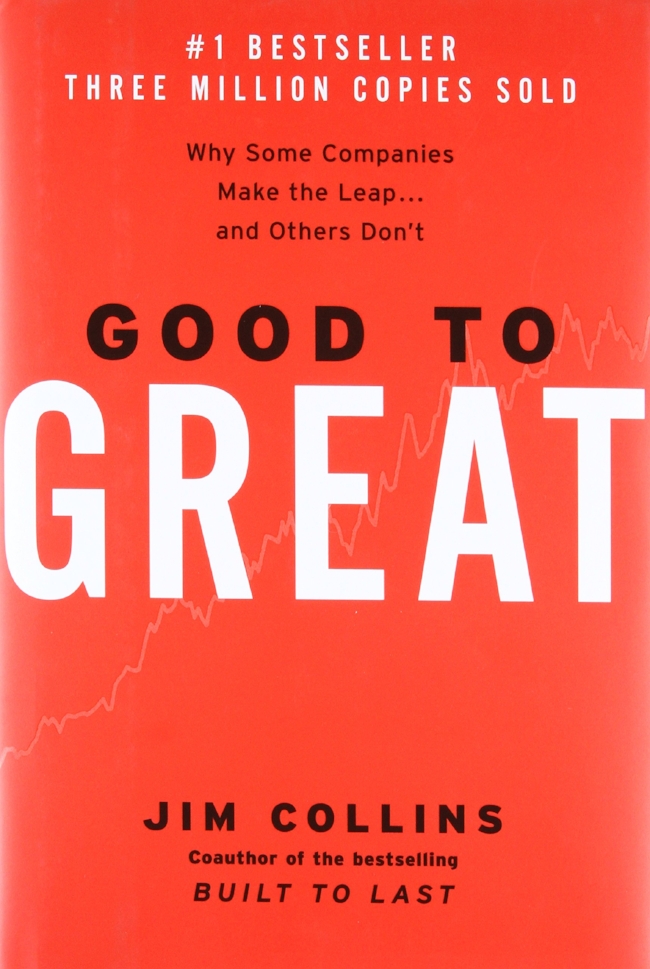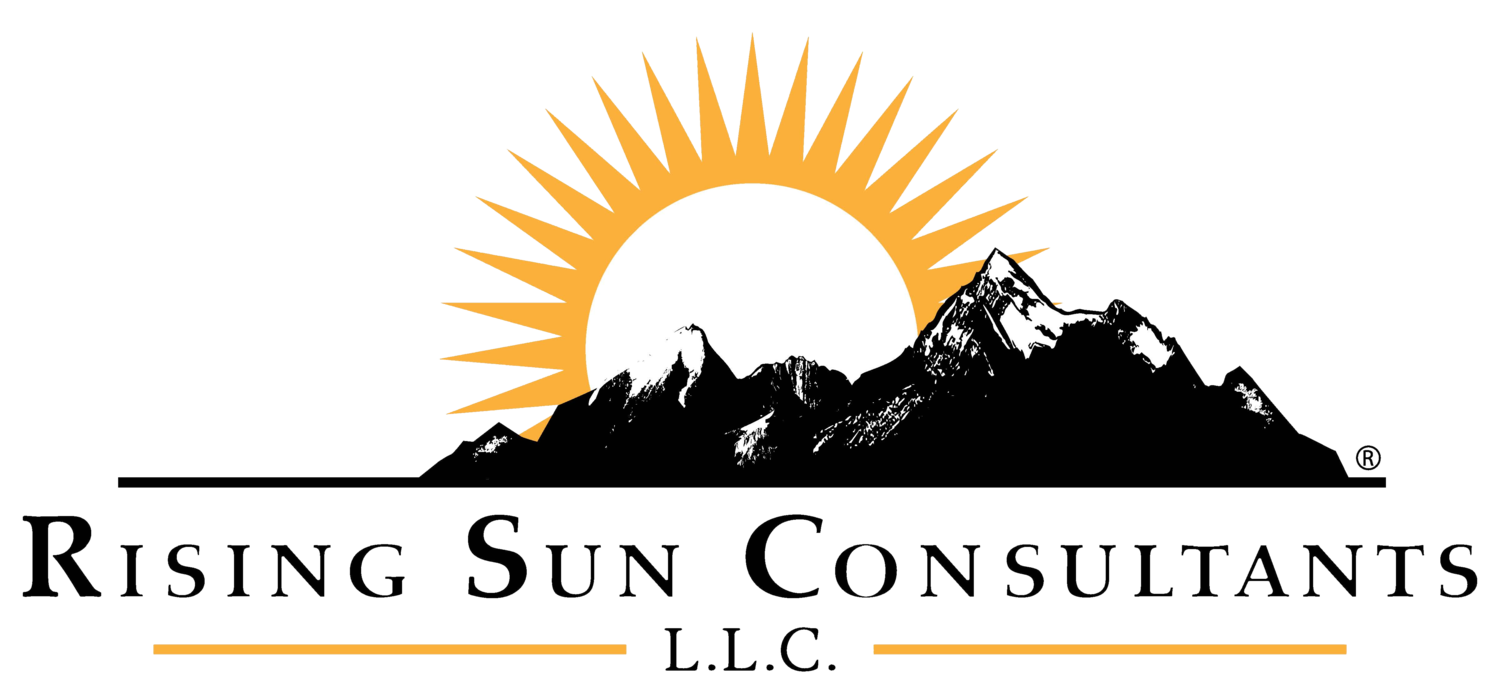BOOK FACTS
- Title: “Good to Great”
- Author: Jim Collins
- Publisher: HarperCollins Publishers, Inc.
- Copyright: 2001
- No. of Pages: 300
- No. of Chapters: 9
RATING (5 RISING SUNS IS A MUST READ – 1 RISING SUN IS LOW INTEREST IN READING)
- Readability: * 4 Suns
- Maintains Attention: * 5 Suns
- Applicability of Information: * 5 Suns
REVIEW
Jim Collins is the one who gets credit for having written “Good to Great.” However, he states clearly in the first few pages that this book would not have been possible without his dedicated and creative research team. This book is based on solid, extensive research of data from multiple companies that added up to approximately 15,000 hours of work, and the fact that Collins credits his team for this effort rather than himself is a demonstration of what the book is about.
A data-driven compilation of company and individual leadership strategies, values and characteristics, this book clearly outlines the approaches that help companies move from the trap of inertia that comes from a company that accepts that doing fine is enough. This is not an easy read, but it is well worth the effort. The reader may consider listening to this book on CD, which presents the vast amount of information in a format which is – according to this reviewer – easier to digest. However, having a hard copy on hand with highlighted sections of interest would be a valuable resource.
The concepts that this book covers are not quick fixes. They will take time, energy and commitment from the top all the way down the ranks. The results, though, are proven and consistent throughout all companies that adopt them.
SUMMARY OF MAIN POINTS
Opening with the premise that “good is the enemy of great,” Collins dives right into the paradigm that he believes prevents companies from growing to being exceptional: that being good, or even quite good, is an acceptable level of achievement. So many organizations are content with good that they don’t even try for more. Some aren’t even sure it is possible to make the shift to long-lasting greatness. And how do you define “good” and “great,” anyway?
For the purpose of his research, Collins defined a “good” company as one with 15 year cumulative stock returns at or below the general stock market. A “great” company had the same 15 year returns as the good companies, but then experienced a transition to a second 15 year cumulative stock returns that were three times the general stock market. This was a very stringent criteria and the number of companies that fit them were limited. Starting with the entire Fortune 500 lists from 1965 to 1995, the numbers narrowed down to 11 “great” companies. These companies were then compared to 11 companies within the same industries that did not make the leap from good to great, and also to a group of six companies (not industry-specific) that made the transition to great, but could not sustain it for the required 15 years. The company list is below:
Good-to-Great Companies Direct Comparisons Unsustained Comparisons
- Abbot Upjohn Burroughs
- Circuit City Silo Chrysler
- Fannie Mae Great Western Harris
- Gillette Warner-Lambert Hasbro
- Kimberly-Clark Scott Paper Rubbermaid
- Kroger A&P Teledyne
- Nucor Bethlehem Steel
- Philip Morris R.J. Reynolds
- Pitney Bowes Addressograph
- Walgreens Eckerd
- Wells Fargo Bank of America
The main concepts that were derived from the data are, when brought together in one organization, a powerful convergence of strategies and values that not only propelled the great companies to the very top of their game, but also enabled them to sustain that greatness. These concepts explained in great detail in the nine chapters of this book are merely highlighted below:
- Level 5 Leadership: A style of leadership that not only encompasses an expertise in management and professional will, but also – and more importantly – a humility that put the success and longevity of their company well before their own gains (money, fame, etc.).
- First Who…Then What: The idea that a company must, before all else, make sure that the right people are on the bus, the wrong people are off the bus, and then the right people are in the right seats. Only then should a company figure out where the bus is going. (This goes against the grain of the Strategic Plan approach, which puts the goals of the company first.)
- Confront the Brutal Facts (Yet Never Lose Faith): Based on the Stockdale Paradox, this strategy proposes that a great company always believes in eventual success, even when the path is extremely difficult. This is not a blind faith, though, as included in this principle is the discipline to face the brutal truth of the current situation.
- The Hedgehog Concept (Simplicity within the Three Circles): This approach addersses what a company does, and asks three questions: 1) What are you deeply passionate about?, 2) What can you be the best in the world at?, and 3) What drives your economic engine? Answering these questions honestly and striving to find that place where these three circles overlap is necessary to be a great organization.
- A Culture of Discipline: This is the concept that if you hire the right people who strive for excellence for the sake of excellence, there will be no need for politics, bureaucracy, excessive controls, or even hierarchy. Having a company full of these people creates a culture of self-discipline.
- Technology Accelerators: All the good-to-great companies in this study did not see technology as the primary catalyst for transitioning to being great, but rather use selected technology as a method to augment the success of the other strategies being implemented.
- The Flywheel and the Doom Loop: Implementing the transition from good to great is represented by the analogy of pushing a huge, heavy flywheel. It is really tough to get it started, and it is slow going for a while. However, if everyone continues pushing in a consistent fashion, the momentum gradually increases.
- From Good to Great to Built to Last: Collins compares the results of this book with those of his previous book, “Built to Last.” He sees “Good to Great” as a prequel to “Built to Last,” and that the concepts of “Good to Great,” which outlines how to make a significant and long-term transition from a good company to a great one, logically flows into the concepts of “Built to Last,” which outlines how to build an enduring great company.
CALL TO ACTION
This book is directed at the top leadership of an organization – the ones who make company-wide decisions. If the leadership is interested in learning how to be Level 5 leaders, and they are committed to turning their good company into a great one, then they must take action. Below are just a few suggestions how to go through the process.
- The organization’s leaders should commit to taking their company to the next level of greatness.
- Require all leaders within the organization to read “Good to Great.” Then, hold many discussions about the book to ensure understanding and to build buy-in of its concepts.
- All leaders, but particularly the top executives, should do a thorough self-examination in regards to their potential for Level 5 Leadership. If they believe they have the fundamental characteristics of a Level 5 Leader, then they must diligently work on building their Level 5 Leadership skills.
- Leaders must decide what characteristics they want their employees to have. Examples include a strong work ethic, desire for excellence, a positive and optimistic outlook on life, etc. Once these characteristics are chosen, they have to review their current staff to decide who will be on the bus, who will be removed from the bus, and then putting those “right people” in the “right seats.”
- Determine the company’s Hedgehog, and design a strategic plan based on that Hedgehog.
- Implement the concepts of “Good to Great.”
- Be patient and consistent.


